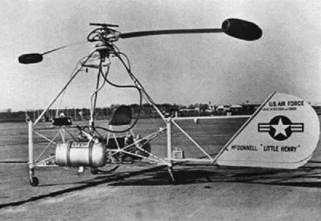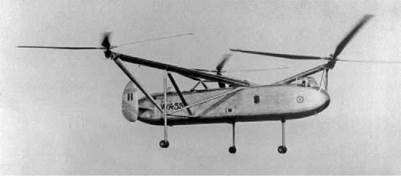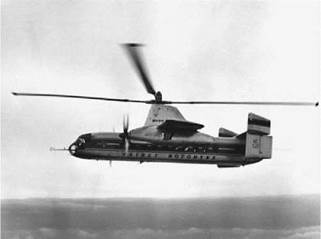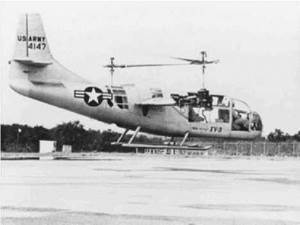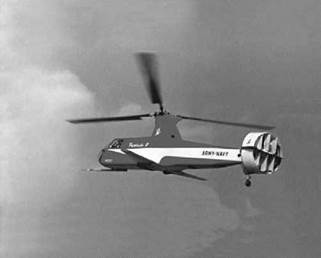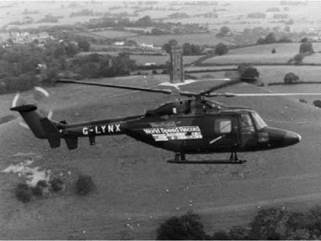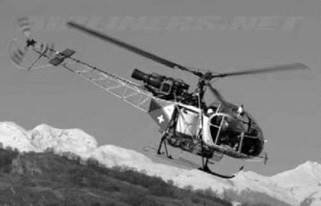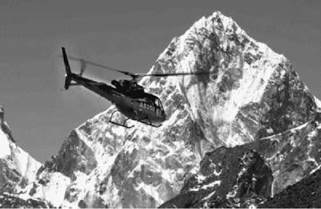Post-war Years
This period saw the emergence of a number of helicopter engineers whose names remain in the forefront of rotary-wing technology today. Bell had Arthur Young, who developed the Bell Bar system of rotor control. Frank Piasecki provided advancement of the tandem configuration with his own company where the compound configuration was added to the portfolio. Charles Kaman, also establishing his own helicopter company, took the Flettner type of rotor forward and also developed conventional rotorcraft layouts. His aircraft designs differed from the mainstream in that the rotor blade pitch control was achieved by using servo flaps placed on the trailing edge of the blades. This caused blade pitch change to be achieved via elastic twisting rather than using a pitch bearing at the rotor head itself. Another helicopter name was borne by
|
Figure 1.8 Bell 47 (Courtesy John Olafson) |
Stanley Hiller. His helicopters used a method of rotor control where a servo paddle was placed underneath the rotor, in an orientation similar to the Bell Bar of Arthur Young. In the Soviet Union we have the names of Mil, Kamov, Yakovlev, Archangleis and Tischenko appearing.
The conditions under which helicopters could operate were extended by the development of de-icing to main and tail rotors, engine inlets, the use of radar altimeters, long-range navigation and Instrument Flight Rules (IFR). The loads carried by helicopter components were becoming heavier and so the move from forgings to castings was being made for rotor heads and transmission.
On 8 December 1945 the Bell 47 – see Figure 1.8 – made its first flight beginning a long contribution to helicopter development. In May 1946 we find the appearance of the first US commercial helicopter in the guise of the Bell 47 CAA Type Cert H-1.
In 1946 W. Laurence LePlage produced the XR1 side-by-side rotorcraft, which was notable since it extended to a tilt rotor configuration. Robert Lichten with the Guerierri Transcendental aircraft model 1G appeared the previous year and he eventually moved to Bell to take responsibility for tilt rotor development.
The year 1947 saw the first all-metal helicopter – the Kellett XR-10 – which became the first twin-engine rotary-winged aircraft for the US Air Force.
Later that year there was the appearance of the McDonnell XH-20 Little Henry – see Figure 1.9. This was the first tip-jet-powered helicopter to be driven by ramjets. This had the disadvantages of a high fuel consumption and noise production, a problem with tip-jet drives which surfaces later in the history of the helicopter.
The following year, in August, saw the Sikorsky S52 become the first helicopter to use allmetal rotor blades. The following month, the Mi-1 (Hare) became the first mass-produced Soviet helicopter.
In 1949, a Hiller Model 12flewthefirsttranscontinentalflightacross theUSAby acommercial helicopter. Also that year, in the UK, the first commercial helicopter began operation after the Bristol Type 171 Sycamore gained a commercial certificate of airworthiness.
In Europe, it was considered that Second World War designs could not be developed satisfactorily, so in 1945 England and France promoted new helicopter concepts. In 1950 Fairey considered the Doblhoff concept of the tip jet. It produced the Fairey Ultralight which
|
Figure 1.9 McDonnell ‘Little Henry’ |
was successfully demonstrated landing and taking off from a lorry at the Farnborough Air Show. This design was stopped in favour of the W14 Skeeter being produced by the Cierva Autogyro Company in Eastleigh/Southampton in England. The Cierva Company had produced its W9 helicopter – see Figure 1.10 – in 1946, which had a novel feature in the tail design. Rather than a conventional tail rotor for torque reaction, it used the tail boom as a plenum chamber and expelled air via a sideways-facing jet. This concept is now used today as the NOTAR system. It also used a different concept for main rotor control. The blades were attached to the hub with a fixed pitch angle which places thrust control on the rotor speed and has the inherent problem of a high rotor inertia preventing rapid changes in rotor speed and hence rotor thrust. The main rotor disc attitude was controlled by physically orientating the main rotor hub into the rotation
|
|
|
Figure 1.11 W11 Air Horse (Courtesy Solent Sky) |
plane required – as already described. This required a significant effort from the pilot and powered controls were needed.
The W11 Air Horse was revolutionary in that it had three main rotors. A rather unusual layout, it was born of a combination of the tandem and side-by-side rotor layouts. It flew from Southampton but ultimately suffered a crash near Romsey about 10 miles from Southampton in June 1950. Figure 1.11 shows the Air Horse.
Fairey Aviation Co. produced a sequence of novel helicopter designs starting in 1947 with the Gyrodyne. This belonged to a type of helicopter known as a compound. In these designs, the main rotor forward propulsion is augmented by a separate propulsive device. In the Gyrodyne, the main rotor torque reaction was achieved with a forward-facing propeller placed on the starboard side of the fuselage. This also generated a forward propulsive thrust. In 1948 it set the world speed record at 200 km/h. In 1954-1955 Fairey developed the Jet Gyrodyne, which hovered for the first time in 1957 and into transition in 1968. The final development by Fairey was the Rotodyne – see Figure 1.12. This was a true convertiplane and demonstrated how one airframe could use powered rotors for vertical take-off and landing but perform transitions to and from autogyro-type forward flight.
|
|
The 1950s and 1960s decades saw many firsts. In June 1950 the world’s first scheduled helicopter passenger service was flown by a British European Airways S51 helicopter. Maiden flights were several: namely, the first turbine helicopter – Kaman K225 in December 1951; the first production rotorcraft with retractable undercarriage – Sikorsky S56 Mojave; the first twin – turbine helicopter – Kaman HTK-1 Huskie; the first Soviet production helicopter – Mi 6 Hook; and the development of the flexstrap rotor hub by Hughes.
In 1962, a Sikorsky S61 was the first helicopter to achieve over 200 mph in level flight; in 1963, the Alouette became the first commercial turbine helicopter in the USA; and in September 1965, the Bell AH1 Cobra became the first dedicated US attack helicopter.
In this period of time several aircraft appeared with the designation XV. In 1955 McDonnell produced the XV1 which was a compound helicopter with the main rotor being based on the Doblhoff concept of the tip jet. It had a wing, a pusher propeller and a twin boom. It achieved flight speeds in excess of 200 mph but suffered from tip-jet noise as did the Fairey Rotodyne.
Sikorsky produced the XV2 in 1952 which had a composite retractable rotor comprising a single blade with a counterbalance weight.
The Bell XV3, see Figure 1.13, of 1955 had a side-by-side rotor layout with each rotor having three blades. It was of the tilt rotor convertiplane configuration. It suffered from long shaft whirl mode instability. In 1958, it was redesigned to have two-bladed rotors with a short shaft.
The XV15 was rolled out in 1976 achieving its first flight in 1979. In 1980 it achieved a flight speed of 300 knots. This aircraft was the forerunner of the V22 which flew for the first time in 1989 and is in extensive use today.
The Kamov Ka22 of 1961 was developed in the Soviet Union and possessed a side-by-side layout. It was unusual in having forward-facing propellers at the wing tips.
In November 1965 we find the Piasecki 16H-1 compound helicopter, see Figure 1.14, making its first flight and achieving 225 mph. This company is still active in the compound helicopter arena. The compound configuration has seen a number of efforts over the years. In the 1960s there was the Sikorsky S65 Blackhawk, a gunship based on the S61 rotor system but with a sleek fuselage shape and fitted with wings. Also in this period there was the Lockheed Cheyenne. Not only was it a compound helicopter with wings and an empennage of intermeshing tail rotor and pusher propeller, but also it had a main rotor controlled by a gyro placed above the main rotor head.
|
|
|
Figure 1.14 Piasecki 16H-1 (Courtesy Piasecki Aircraft Corp.) |
We also now begin to see the emergence of extended mission lengths. In 1965, Gary Maher piloted a Hughes 300 to achieve the first solo crossing of the USA. It was a 10 day flight and required 33 refuelling stops. In 1967, a Sikorsky S61 was the first helicopter to achieve the notable goal of crossing the Atlantic Ocean. It took another 15 years (30 September 1982) before a Bell 206-1 became the first helicopter to achieve circumnavigation of the Earth. In July of the following year a Bell Jet Ranger was piloted to the first solo global circumnavigation.
Speed has always been the touchstone of the rotary-wing aircraft and there are many attempts at achieving fast forward flight. Among many, in the UK the most notable of late happened on 11 August 1986. On this date, a Westland Lynx helicopter, flying over the Somerset Levels with Trevor Egginton at the controls, obtained the class world speed record of 400km/h – see Figure 1.15.
|
|
|
Figure 1.16 Alouette SA 315 Lama (Courtesy Steve Rod) |
|
Figure 1.17 Eurocopter AS350 in the Himalaya (Courtesy Eurocopter) |
The highest altitude was achieved by an Alouette SA315 Lama on 21 June 1972 when it flew to 40 820 ft – see Figure 1.16.
While this remains the altitude record it should not be forgotten that on 14 May 2005 a Eurocopter AS350 helicopter, piloted by Didier Delsalle, was the first to land on the summit of Mount Everest (see Figure 1.17), the highest point on Earth.
Just to prove the point, because of equipment difficulties, it did it again the following day!












